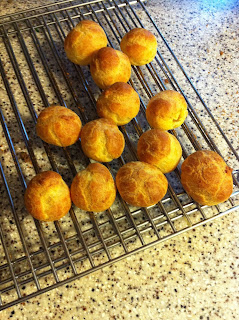There was a lot of knife work, though.
Let me take you back a few weeks. When we were doing Food Lab: Pasta, the Mad Kitchen Scientist informed us that he had a hookup to get a freshly slaughtered lamb or two. All of us perked up, particularly when he informed us that we could likely do the butchering.
Sure enough, he was able to secure two lambs (affectionately nicknamed Bo and Peep), which were slaughtered a week ago, skinned and gutted, and allowed to hang. Mad Kitchen Scientist picked them up Saturday, and brought them to our place for cutting up Sunday (we have the most counter space).
The IAs were unable to join us, and The Executive Committee, less interested in the process of cutting up an animal and perhaps a little squicked out, decided that watching football while knitting was the better part of valor.
So we aproned up, collected extra paper towels and bandages, sharpened the knives, cracked open Whole Beast Butchery, and got to work.
What did we learn?
There's a reason butchers have band saws. We had a hack saw, and with some elbow grease it did work to do things like sever the neck from the spine, crack the breastbone, split the spine and pelvis, and separate the joints. And when the hack saw didn't cut it (no pun intended), we had a cleaver and a mallet at hand.
Before you ask: yes, we all cut ourselves, but none of us seriously.
The main disassembly actually happened pretty quickly. The steps were:
- Separate the neck from the rest of the body (and save it for stock or merguez)
- Separate the upper rib cage between the 5th and 6th ribs
- Separate the lower rib cage between the 12th and 13th ribs
- Separate the "saddle" (which includes the pelvis)
- Remove the back legs at the hip joints
Then we got into the fine work. Which took about five hours.
The upper rib cage turns into two shoulder roasts and two shoulder racks, plus the forelegs come off for the stockpot.
The lower rib cage is where you get your rack of lamb, Frenched or not (your choice), or lambchetta (which is like porchetta but, of course, with lamb).
The saddle becomes tenderloin, boneless loin chops, or lamb "porterhouses" (bone in loin chops).
The legs get boned out into roughly five sections per leg, with each leg producing 4-5 pounds of meat.
Plus each lamb gave us about four pounds of sausage meat.
Of course, we also got the heart, kidneys (still attached to the main carcass upon arrival), and the liver for both lambs.
And we rendered out about 10 cups of lamb fat.
Does that sound like a lot of work? It was.
What did we learn?
I don't think we appreciate butchers enough. This is hard work.
If you're going to do this, you MUST have a reliable method of sharpening your knives at home. We had to stop to resharpen multiple times. You also need multiple hack saw blades.
We probably didn't need the practice lamb, which was ostensibly why we got two. Yes, the second time around did go a little more smoothly, but as long as you pay attention to the lamb's anatomy, you won't go far wrong in your cuts even on the first lamb. But having two made it much easier to divide things up among three couples.
It did kind of make a mess. Not blood - the lamb had hung for a week, so there was very little blood left. But things did get pretty greasy. It took me and Chef Spouse about two hours to clean up after we were done.
If you're going to try this at home, you need at least two people for purposes of hefting, holding, and cutting the carcass. You need plenty of counter space. You need ample time. You need a hack saw, a cleaver, a mallet, and SHARP boning knives. You need a large freezer to store the results of your labors.And you probably want to plan to get take out, because you aren't going to feel like cooking after.
Next up: Butchering, Part 2, where we make stock with all the bones and sausage with the leftover bits and ends, and the rendered fat.

























